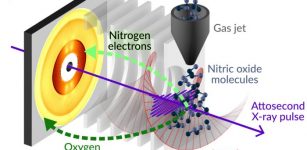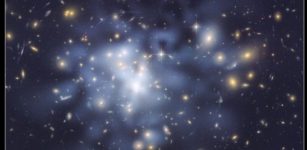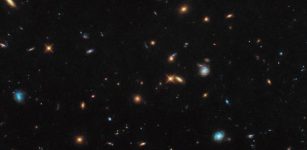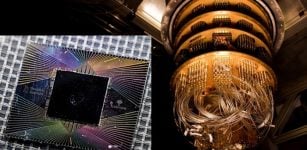New Model For Matter In Neutron Star Collisions
Eddie Gonzales Jr. – MessageToEagle.com – With the exception of black holes, neutron stars are the densest objects in the universe.
As their name suggests, neutron stars are mainly made of neutrons. However, our knowledge about the matter produced during the collision of two neutron stars is still limited. Scientists from Goethe University Frankfurt and the Asia Pacific Center for Theoretical Physics in Pohang have developed a model that gives insights about matter under such extreme conditions.
Illustration of the new method: the researchers use five-dimensional black holes (right) to calculate the phase diagram of strongly coupled matter (middle), enabling simulations of neutron star mergers and the produced gravitational waves (left). Credit: Goethe University Frankfurt am Main
After a massive star has burned its fuel and explodes as a supernova, an extremely compact object, called a neutron star, can be formed. Neutron stars are extraordinarily dense: To reach the density inside them, one would need to squeeze a massive body like our sun down to the size of a city like Frankfurt. In 2017, gravitational waves, the small ripples in spacetime that are produced during a collision of two neutron stars, could be directly measured here on earth for the first time.
However, the composition of the resulting hot and dense merger product is not known precisely. It is still an open question, for instance, whether quarks, which are otherwise trapped in neutrons, can appear in free form after the collision. Dr. Christian Ecker from the Institute for Theoretical Physics of Goethe University Frankfurt, Germany, and Dr. Matti Järvinen and Dr. Tuna Demircik from the Asia Pacific Center for Theoretical Physics in Pohang, South Korea, have developed a new model that allows them to get one step closer to answering this question.
In their work published in Physical Review X, they extend models from nuclear physics, which are not applicable at high densities, with a method used in string theory to describe the transition to dense and hot quark matter.
“Our method uses a mathematical relationship found in string theory, namely the correspondence between five-dimensional black holes and strongly interacting matter, to describe the phase transition between dense nuclear and quark matter,” explain Dr. Demircik and Dr. Järvinen.
“We have already used the new model in computer simulations to calculate the gravitational-wave signal from these collisions and show that both hot and cold quark matter can be produced,” adds Dr. Ecker, who implemented these simulations in collaboration with Samuel Tootle and Konrad Topolski from the working group of Prof. Luciano Rezzolla at Goethe University in Frankfurt.
Next, the researchers hope to be able to compare their simulations with future gravitational waves measured from space in order to gain further insights into quark matter in neutron star collisions.
Written by Eddie Gonzales Jr. – MessageToEagle.com Staff











